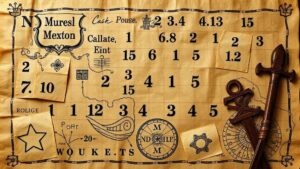Recognizing Clues That Use Animal Imagery to Indicate Treasure Sites
Recognizing Clues That Use Animal Imagery to Indicate Treasure Sites
Animal imagery has been utilized in various cultures across the globe as a symbolic means to indicate treasure, sacred sites, and hidden riches. This form of cryptic communication often requires an understanding of the cultural significance of the animals depicted. In this article, we will delve into the various ways animal imagery can serve as clues to treasure sites, supported by historical examples and an analysis of cultural contexts.
The Significance of Animal Symbolism
Throughout history, animals have symbolized various traits and themes, reflecting the societies that venerate them. From ancient civilizations to modern folklore, the meanings attached to certain animals can guide treasure hunters in identifying potential treasure sites. Understanding these symbols is crucial for anyone looking to decode treasure maps or signs.
For example, in Native American cultures, the eagle is often seen as a messenger and a symbol of spiritual protection. If a treasure clue involves the imagery of an eagle, it may suggest that the treasure is protected by spiritual means or is intended for someone possessing certain virtues.
Types of Animal Imagery in Treasure Clues
Clues involving animal imagery can take various forms, including carvings, shadow patterns, or even geographical formations resembling animal shapes. Here are some common types:
- Carvings and Statues: Ancient ruins may contain carvings of animals associated with lore about hidden treasures.
- Geographical Features: Landscapes can mimic animal forms, suggesting that the area may hide something valuable.
- Diverse Artwork: Pottery, textiles, and murals often incorporate animals to tell stories, some of which may lead to treasure.
Case Studies of Treasure Sites Connected to Animal Clues
Several well-documented treasure hunts have successfully utilized animal imagery as clues. One notable example is the “Hidden Treasure of Oak Island,” which has captured the imaginations of treasure hunters for generations. Among various symbols, the image of a dog was reportedly found, possibly indicating that the treasures guardianship was related to loyalty and protection.
Also, in Peru, the legendary “Lost City of Gold,” often referenced in connection with animals, reveals that the Inca civilization frequently utilized dynamic images of condors in their art. Local lore suggests that following the condor imagery could lead treasure seekers to sacred sites that contain forgotten riches.
Deciphering Animal Imagery
Deciphering the meaning behind animal imagery involves several steps. The first step is identifying the animal and its historical or cultural significance. This may require research into various mythologies and folklore. next step involves understanding the context in which the imagery appears; is it within a sacred site, or is it embedded in mundane objects?
Also, understanding local legends and stories can provide insight into potential locations for treasures. For example, many cultures have tales of animals leading seekers to hidden wealth, often personifying the animals as guides or guardians.
Challenges in Recognizing Clues
While deciphering animal imagery can be intriguing, it comes with challenges. Misinterpretation of symbols can lead treasure hunters astray. For example, what might appear as a clue in one culture could hold a completely different meaning in another. Plus, the deterioration of ancient artifacts can obscure the intended messages.
- Contextual Variability: Symbols may vary widely in meaning across cultures, requiring extensive knowledge.
- Physical Erosion: Natural elements can degrade clues, making them difficult to analyze.
Actionable Takeaways
For those interested in treasure hunting through animal imagery, here are a few actionable takeaways:
- Research the cultural significance of animals within the region you are exploring.
- Visit local historical societies or museums that may offer insights into regional myths and artifacts.
- Consider collaboration with experts in archaeology or anthropology for a deeper understanding of symbols.
Recognizing animal imagery that indicates treasure sites involves both art and science, combining cultural studies with historical context. By approaching this topic with curiosity and diligence, you can enhance your treasure-seeking endeavors while deepening your appreciation for the rich tapestry of human history.

